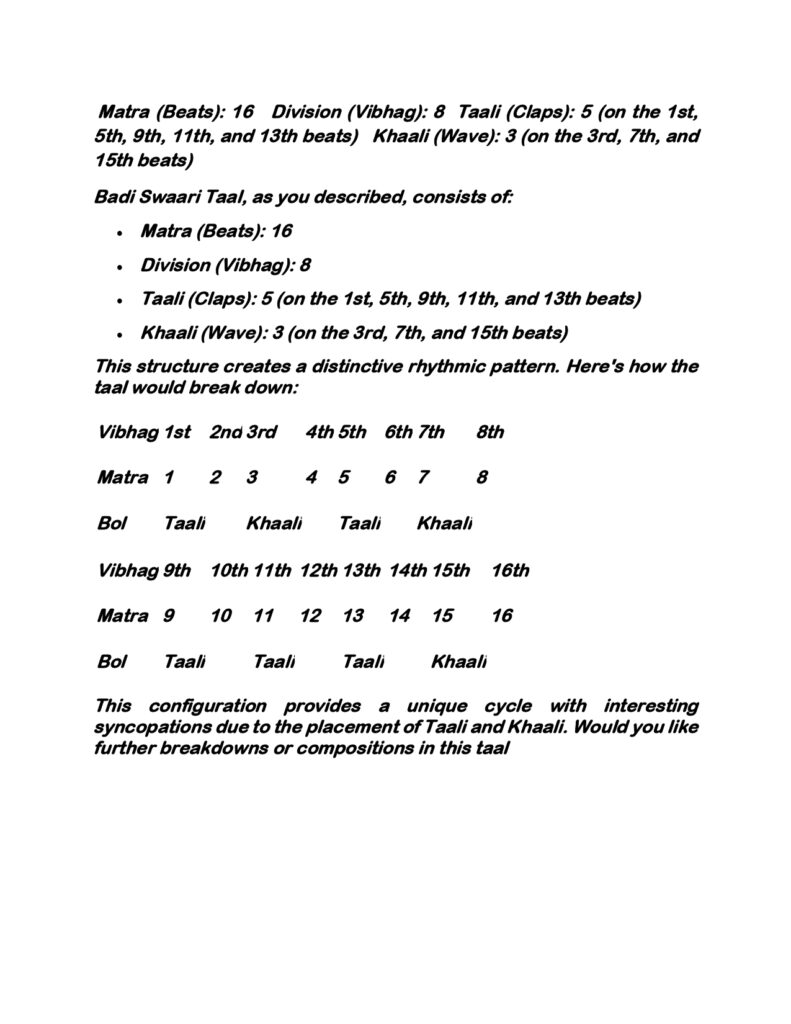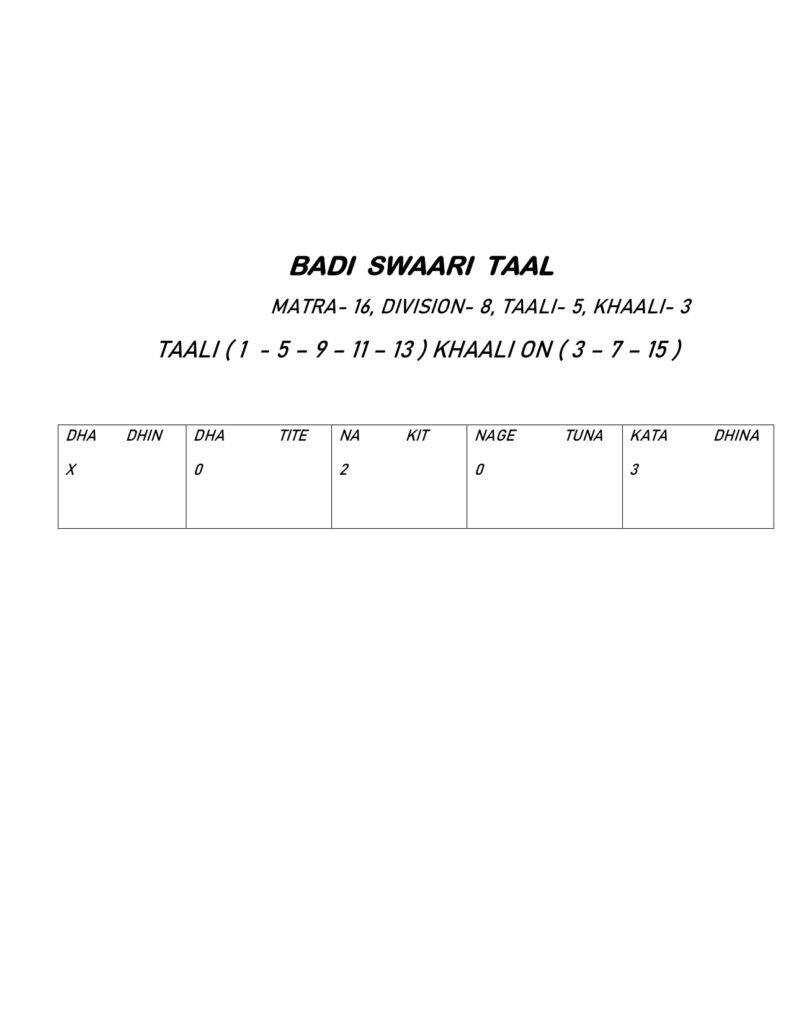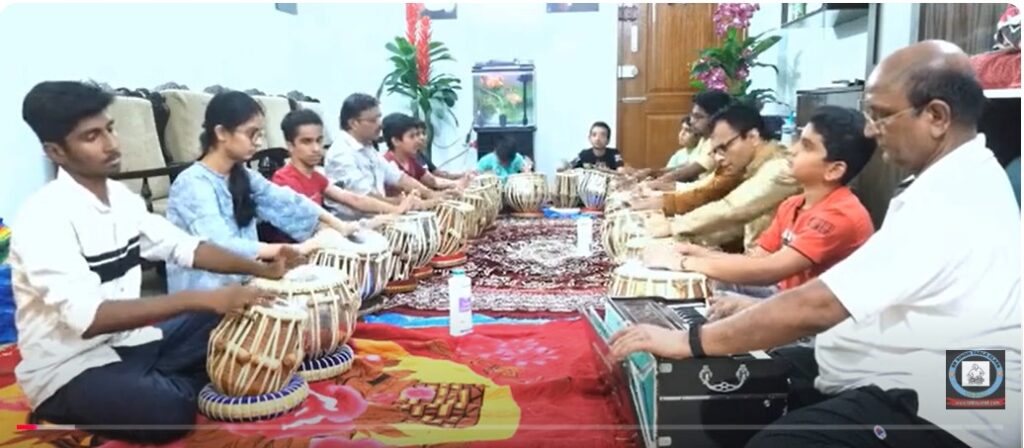Badi Swaari Taal Theka, Badi Swaari Taal is a 16-beat rhythmic cycle with 8 divisions. It features 5 Taali (claps) on beats 1, 5, 9, 11, and 13, and 3 Khaali (waves) on beats 3, 7, and 15. This unique structure creates a rich, syncopated rhythm ideal for classical and semi-classical compositions in Indian music.This description highlights the key elements of the taal—matra, division, taali, and khaali—in a concise format for quick understanding.
Introducing the-


https://www.youtube.com/@BhagawanSingh
https://www.facebook.com/sbsinghtablaguru
Badi Swaari Taal is an intricate rhythmic cycle used in Indian classical music, offering a distinct structure that creates a complex, syncopated pattern. Here is a more detailed breakdown:
Key Features:
- Matra (Beats): 16
- This taal consists of 16 beats in total, providing a medium-length cycle often used in compositions that require detailed rhythmic exploration.
- Division (Vibhag): 8
- The 16 beats are divided into 8 Vibhag (sections), creating shorter, manageable groupings of 2 beats each.
- Taali (Claps): 5
- Taali, or clapping, emphasizes specific beats. In Badi Swaari Taal, the claps are placed on the 1st, 5th, 9th, 11th, and 13th beats. These claps mark the important points of the cycle.
- Khaali (Wave): 3
- Khaali, or wave (no clap), is an important aspect of Indian rhythm, often marking a soft or resting point in the cycle. In this taal, Khaali is placed on the 3rd, 7th, and 15th beats, adding to the syncopation and giving the taal its distinctive flow.
Beat Structure:
- 1st Vibhag (Beats 1–2): Taali on beat 1, setting the rhythmic tone right from the beginning.
- 2nd Vibhag (Beats 3–4): Khaali on beat 3, giving a soft rest early in the cycle.
- 3rd Vibhag (Beats 5–6): Taali on beat 5, reintroducing the clap for emphasis.
- 4th Vibhag (Beats 7–8): Khaali on beat 7, another soft rest, providing balance.
- 5th Vibhag (Beats 9–10): Taali on beat 9, marking an important transition within the cycle.
- 6th Vibhag (Beats 11–12): Taali on beat 11, another point of emphasis.
- 7th Vibhag (Beats 13–14): Taali on beat 13, followed by a smooth flow towards the end.
- 8th Vibhag (Beats 15–16): Khaali on beat 15, with beat 16 completing the cycle in a quiet rest.
Flow and Use in Music:
- Syncopation: The combination of claps and waves creates a syncopated rhythm, where the strong and weak beats alternate fluidly, adding depth to compositions.
- Aesthetic Appeal: The taal’s distinct arrangement of Taali and Khaali makes it suitable for classical dance performances, instrumental music, and semi-classical vocal compositions.
- Cyclic Nature: As with most taals, Badi Swaari Taal has a cyclic nature, meaning that after reaching beat 16, the cycle begins again from beat 1, continuing in repetition.
Application:
- Vocal Music: Badi Swaari Taal can be used in light classical vocal forms like Thumri, Dadra, and Kajri, providing a gentle yet complex rhythmic foundation.
- Dance Forms: It may also be used in classical dance forms like Kathak, where dancers can highlight the interplay of Taali and Khaali with footwork.
Badi Sawaari Taal in Kathak and Indian Classical Music
Badi Sawaari Taal (also spelled as Badi Sawari or Badi Savari) is a unique and less common rhythmic cycle used in Indian classical music and dance, particularly in Kathak. It is notable for its distinct structure and intricate rhythmic possibilities.
Structure of Badi Sawaari Taal
- Beats (Matras): Typically 14 beats per cycle.
- Vibhag (Divisions): Divided into 4 sections.
- 1st Vibhag: 4 beats
- 2nd Vibhag: 4 beats
- 3rd Vibhag: 4 beats
- 4th Vibhag: 2 beats
- Tali (Claps) and Khali (Wave):
- Tali: 1st (Sam) and 9th beats.
- Khali: 13th beat.
Bols of Badi Sawaari Taal
The typical syllables for Badi Sawaari Taal are:
Dha Dhin Dhin Dha | Dha Dha Tin Tin | Na Tin Tin Na | Dha Tin
Applications in Kathak
- Dance Compositions:
- Used in todas, tukras, and chakradar patterns, showcasing intricate footwork and rhythmic finesse.
- The uneven distribution of beats allows for creative variations and improvisations.
- Tabla Accompaniment:
- The tabla player crafts unique rhythmic phrases (kaidas and relas) for Badi Sawaari Taal.
- It highlights the performer’s ability to navigate complex rhythmic structures.
- Performance Aesthetics:
- Often used to present slower compositions (vilambit laya) that gradually speed up to drut laya.
- Creates a dramatic and dynamic atmosphere in Kathak recitals.
Why is it Unique?
- Rhythmic Asymmetry: While most common taals have equal divisions (e.g., Teen Taal’s 4+4+4+4 structure), Badi Sawaari Taal’s final division of 2 beats adds asymmetry.
- Room for Improvisation: The unusual structure challenges dancers and musicians to experiment with their creativity.
Famous Performances Using Badi Sawaari Taal
- Kathak maestros such as Birju Maharaj and Shovana Narayan have experimented with Badi Sawaari Taal in their choreographies.
- Renowned tabla players like Zakir Hussain and Anindo Chatterjee have also used this taal in their solo performances.
Keywords for Badi Sawaari Taal
- #BadiSawaariTaal
- #KathakTaal
- #RhythmicPatterns
- #TablaComposition
- #IndianClassicalDance


